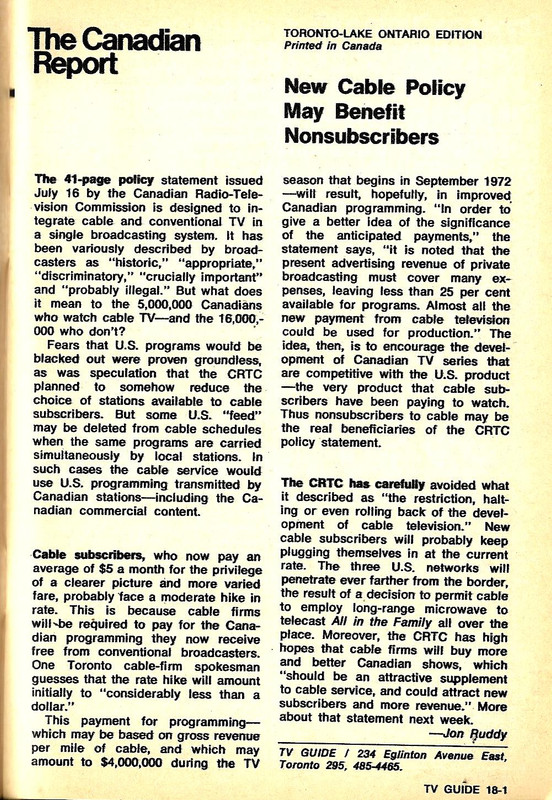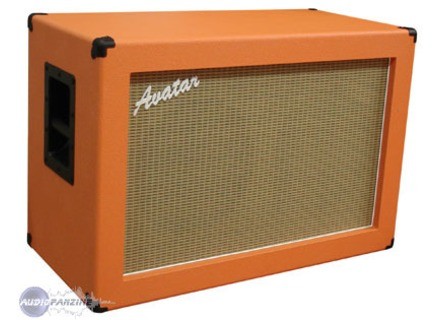- RadioActive
- Moderator
 Offline
Offline
The Origins Of Simsub On Canadian Cable
I was going through some old articles I found in my archives and came across this one, from an August 1972 TV Guide. It gives the very first hint of the policy we now know as simultaneous substitution, although it wasn't quite clear how it was going to work back then.
I have to admit I didn't think it went back quite that far. It was just the beginning of cable becoming a factor in Canada and up until that time, many stations north of the border scheduled their American-bought programming at differnt times of the night, and only occasionally in pattern with the U.S. networks. It was this decision that changed that forever and led to what we see (and some of us lament) to this day.
Also interesting to note the reference to the cost of cable back then - $5 a month! Those truly were the days!
- Radiowiz
- Member
 Offline
Offline 
Re: The Origins Of Simsub On Canadian Cable
RadioActive wrote:
Also interesting to note the reference to the cost of cable back then - $5 a month! Those truly were the days!
$5 CDN in 1972 is worth approximately $37 in today's times.
Rogers Basic cable today is $25.
Where things have REALLY changed is that it's $20 on top of that $25 a month to be able to have cable (ignite TV) in the home. ($10 ignite TV box rental + $10 gateway fee)
So,
perhaps one can gather that, based strictly on basic cable
(or matching 1972 with today, without adding any extra channels)
Rogers is charging $8 more than what they really should if everything could be exactly the same as it was in 1972.
(channel lineup and all...as close as possible)
- Peter the K
- Member
 Offline
Offline 
Re: The Origins Of Simsub On Canadian Cable
I remember back in 1970 my dad splurging on cable. Yes it was $5/month but if you paid a year in advance it cost $50/year.
But then again, you only got about 10 channels.
I remember the first time I encountered sim-sub. It would have been in the early 70s. I remember watching a show on WGR channel 2 and after the show, the CKCO channel 13 station ID came on the screen. At the time, I thought there was something wrong with the TV.
- paterson1
- Member
 Offline
Offline
Re: The Origins Of Simsub On Canadian Cable
Sim sub whether anyone likes it or not has been and continues to be a necessary evil. The Americans for the most part like it because they can charge more money for programming. Canadian networks pay dearly for exclusive rights for these shows and that's what they get. Prior to sim sub they were not getting exclusive rights, and neither were US border stations. Also as we know Canadian networks programmed most of these shows on different days and times, and usually prior to the US network.
Those that don't like sim sub should note that because of COVID and the strike, there hasn't been as much sim sub in prime time anyway over the past three years. And Canadian networks have not opted for a lot of the "strike programming" being offered up on the US OTA networks.
On CTV, CTV2, Global and City during this time domestic programming has actually been getting better time slots and more promotion because the networks don't have much else to run. How are the domestic summer shows doing for ratings?? Nobody knows but the networks.
I found it interesting that even for great ratings like the recent Canadian Open Golf Tournament , or Canadian Grand Prix, Bell chose not to release the numbers for these events in The Lede or anywhere else. However in last weeks 2nd quarter update for BCE for investors and the business community, ratings for these two events were included.
- zed
- Member
 Offline
Offline
Re: The Origins Of Simsub On Canadian Cable
CRTC rules for simsub used to be that to qualify a station must have a B contour into the area, leading to stations like CJOH and CKCO adding rebroadcasters into highly populated regions their originating transmitter didn't cover. CKCO had 4 transmitters providing coverage from Windsor to Toronto and north to Georgian Bay and Muskoka. All of the rebroadcasters have been shut down but I bet the CTV signal is simsub over US networks in all of the cities it used to, even without the transmitters.
Unless the rules have changed should this be allowed?
- mace
- Member
 Offline
Offline
Re: The Origins Of Simsub On Canadian Cable
Canadian stations get simsubbed as well. In Toronto, for most of the broadcast day the CKCO signal is replaced by CFTO.
- Hansa
- Member
 Offline
Offline
Re: The Origins Of Simsub On Canadian Cable
The pre-simsub practice of Canadian stations airing US programming a day or two before US networks was exploited by Jamestown-Buffalo station WNYP which became CTV's first and only US affiliate in the 1960s and managed to air American prime time series ahead of the actual NBC, CBS and ABC affiliates in Buffalo. That ended in 1969 when WKBW, WGR, and WNED threatened to take WNYP to court.
Last edited by Hansa (August 7, 2023 6:08 pm)
- Forward Power
- Member
 Offline
Offline 
Re: The Origins Of Simsub On Canadian Cable
mace wrote:
Canadian stations get simsubbed as well. In Toronto, for most of the broadcast day the CKCO signal is replaced by CFTO.
During my college years in Belleville, Kingston's CKWS and Peterborough's CHEX were both on the local Cogeco system, and 'WS would show up on both channels, except during local newscasts and any other non-simultaneous programming, such as TV Bingo.
 1 of 1
1 of 1